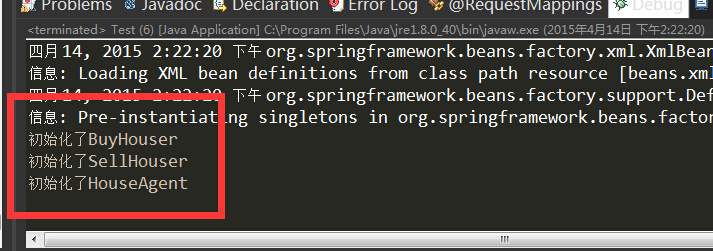本文主要讲了Spring中Bean之间的关系,分为继承、依赖和引用三个类型。文章中都分别有例子和用法分析。
一、继承Bean配置
- Spring允许继承bean的配置 ,被继承的bean称为父bean,继承这个父Bean的Bean称为子Bean
- 子Bean从父Bean中继承配置,包括Bean的属性配置
- 子Bean也可以 覆盖 从父Bean继承过来的配置
- 父Bean可以作为配置模版,也可以作为Bean实例, 若只想把父Bean作为模版,可以配置<bean>的abstract属性为true ,这样Spring将不会实例化这个Bean
- 并不是<bean>元素里的所有属性都会被继承 。比如:autowire,abstract等。
- 也 可以忽略父Bean的class属性 ,让子Bean指定自己的类,而共享相同的属性配置,但此时 abstract必须设为true
使用案例:
定义House.java:
如果多个bean存在相同的配置信息,Spring允许我们定义一个父,子将自动继承父的配置信息。
使用: 输出结果:
房子大小:150坪 房子位置:汇景苑 房子价格:15万
房子大小:150坪 房子位置:科苑花园 房子价格:8万
house1跟house2都继承自abstracthouse,Spring会将父bean的配置信息传递给子bean,如果子bean提供了父bean已有的配置信息,那么子bean的会覆盖父bean的.
父bean的功能主要是为了简化子bean的配置,所以一般声明为abstract=“true”,表示这个不实例化为一个对应的Bean,如果用户不指定该属性为true,那么IOC容器会实例化一个名叫abstractcar的Bean。
二、依赖Bean配置
- Spring允许用户通过depends-on属性设定Bean前置依赖的Bean ,前置依赖的Bean会在本Bean实例化之前创建好
- 如果前置依赖于多个Bean,则可以通过逗号,空格或的方式配置Bean的名称
depends-on:
depends-on属性可以用于当前bean初始化之前显式地强制一个或多个bean被初始化。下面的例子中使用了depends-on属性来指定一个bean的依赖。
若需要表达对多个bean的依赖,可以在'depends-on'中将指定的多个bean名字用分隔符进行分隔,分隔符可以是逗号、空格及分号等。下面的
例子中使用了'depends-on'来表达对多个bean的依赖。
在XML配置文件中,延迟初始化将通过<bean/>元素中的lazy-init属性来进行控制。例如:
当ApplicationContext实现加载上述配置时,设置为lazy的bean-buyHouser将不会在ApplicationContext启动时提前被实例化,而not.lazy--sellHouser却会被提前实例化。
需要说明的是,如果一个bean被设置为延迟初始化,而另一个非延迟初始化的singleton bean依赖于它,那么当ApplicationContext提前实例化singleton bean时,它必须也确保所有上述singleton 依赖bean也被预先初始化,当然也包括设置为延迟实例化的bean。因此,如果Ioc容器在启动的时候创建了那些设置为延迟实例化的bean的实例,你也不要觉得奇怪,因为那些延迟初始化的bean可能在配置的某个地方被注入到了一个非延迟初始化singleton bean里面。
使用范例:
1.买房人BuyHouser.java
2、卖房人SellHouser.java
3、房屋中介HouseAgent.java
4、beans.xml
5、测试
结果:

注意,这里我将BuyHouser和SellHouser都设置成lazy-init="true",但是由于房屋中介HouseAgent依赖到它们两个,所以你你加载这个beans.xml文件时,还是会先把BuyHouser和SellHouser实例化。
depends-on属性可以用于当前bean初始化之前显式地强制一个或多个bean被初始化。下面的例子中使用了depends-on属性来指定一个bean的依赖。
若需要表达对多个bean的依赖,可以在'depends-on'中将指定的多个bean名字用分隔符进行分隔,分隔符可以是逗号、空格及分号等。下面的
例子中使用了'depends-on'来表达对多个bean的依赖。
延迟初始化bean;
在XML配置文件中,延迟初始化将通过<bean/>元素中的lazy-init属性来进行控制。例如:
当ApplicationContext实现加载上述配置时,设置为lazy的bean-buyHouser将不会在ApplicationContext启动时提前被实例化,而not.lazy--sellHouser却会被提前实例化。
需要说明的是,如果一个bean被设置为延迟初始化,而另一个非延迟初始化的singleton bean依赖于它,那么当ApplicationContext提前实例化singleton bean时,它必须也确保所有上述singleton 依赖bean也被预先初始化,当然也包括设置为延迟实例化的bean。因此,如果Ioc容器在启动的时候创建了那些设置为延迟实例化的bean的实例,你也不要觉得奇怪,因为那些延迟初始化的bean可能在配置的某个地方被注入到了一个非延迟初始化singleton bean里面。
使用范例:
1.买房人BuyHouser.java
2、卖房人SellHouser.java
3、房屋中介HouseAgent.java
4、beans.xml
5、测试
结果:

注意,这里我将BuyHouser和SellHouser都设置成lazy-init="true",但是由于房屋中介HouseAgent依赖到它们两个,所以你你加载这个beans.xml文件时,还是会先把BuyHouser和SellHouser实例化。
三、引用Bean配置
代码结构:
可写成
或写成
<ref local="xx"/>
用"local"属性指定目标其实是指向同一文件内对应"id"属性值为此"local"值的索引"local"属性的值必须和目标bean的id属性相同。如果同一文件内没有匹配的元素,xml解析器将提示错误。同样,如果目标在同一XML文件内,使用"local"变量是最好的选择(为了尽可能早地知道错误)
<ref bean="xx"/>
用"bean"属性指定目标bean是最常规的形式,这允许创建索引到任何同一个容器内的bean(无论是否在同一XML文件中)或者父级的容器内的bean。"bean"属性的值可以和目标bean的"id"属性相同,也可以和目标bean的"name"属性内的一个值相同
1 、用 local 属性指定目标 bean 可以利用 xml 解析器的能力在同一个 XML配置文件中验证 xml id 引用,没有匹配的元素,xml 解析器就会产生一个 error, 所以如果引用的 bean 在同一个 XML配置 文件中 , 那么用 local 形式是最好的选择 .
2 、可以这么说,<ref bean> 是寻找所有 XML配置文件中的 bean; <ref local> 是寻找本 xml 文件中的 bean.
3 、<ref> 提供了如下几方面的属性 :
1)bean: 在当前 Spring XML 配置文件中,或者在同一 BeanFactory(ApplicationContext) 中的其他 JavaBean 中寻找引入的BEAN.
2)local: 仅在当前 Spring XML 配置文件中寻找引入的BEAN.
如果借助于 Spring IDE, 则在编译期可以对其依赖的 JavaBean 进行验证。基于 local 方式,开发者能够使用到 XML 本身提供的优势,而进行验证。 3)parent: 用于指定其依赖的父 JavaBean 定义。
林炳文Evankaka原创作品。转载请注明出处 http://blog.csdn.net/evankaka
可写成
或写成
<ref local="xx"/>
用"local"属性指定目标其实是指向同一文件内对应"id"属性值为此"local"值的索引"local"属性的值必须和目标bean的id属性相同。如果同一文件内没有匹配的元素,xml解析器将提示错误。同样,如果目标在同一XML文件内,使用"local"变量是最好的选择(为了尽可能早地知道错误)
<ref bean="xx"/>
用"bean"属性指定目标bean是最常规的形式,这允许创建索引到任何同一个容器内的bean(无论是否在同一XML文件中)或者父级的容器内的bean。"bean"属性的值可以和目标bean的"id"属性相同,也可以和目标bean的"name"属性内的一个值相同
1 、用 local 属性指定目标 bean 可以利用 xml 解析器的能力在同一个 XML配置文件中验证 xml id 引用,没有匹配的元素,xml 解析器就会产生一个 error, 所以如果引用的 bean 在同一个 XML配置 文件中 , 那么用 local 形式是最好的选择 .
2 、可以这么说,<ref bean> 是寻找所有 XML配置文件中的 bean; <ref local> 是寻找本 xml 文件中的 bean.
3 、<ref> 提供了如下几方面的属性 :
1)bean: 在当前 Spring XML 配置文件中,或者在同一 BeanFactory(ApplicationContext) 中的其他 JavaBean 中寻找引入的BEAN.
2)local: 仅在当前 Spring XML 配置文件中寻找引入的BEAN.
如果借助于 Spring IDE, 则在编译期可以对其依赖的 JavaBean 进行验证。基于 local 方式,开发者能够使用到 XML 本身提供的优势,而进行验证。 3)parent: 用于指定其依赖的父 JavaBean 定义。
林炳文Evankaka原创作品。转载请注明出处 http://blog.csdn.net/evankaka






















 981
981











 被折叠的 条评论
为什么被折叠?
被折叠的 条评论
为什么被折叠?








